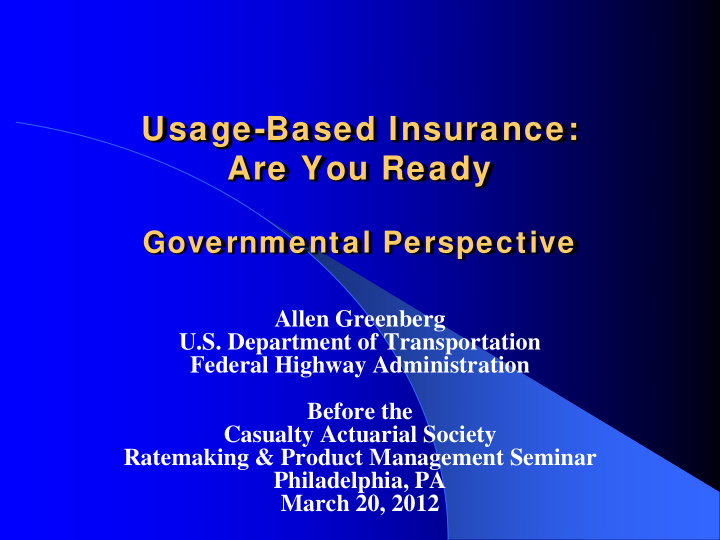



Usage-Based Insurance: Are You Ready Governmental Perspective Allen Greenberg U.S. Department of Transportation Federal Highway Administration Before the Casualty Actuarial Society Ratemaking & Product Management Seminar Philadelphia, PA March 20, 2012
What is PAYDAYS Pricing and its Relationship to UBI? Pay-as-you-drive-and-you-save (PAYDAYS) pricing converts hidden and lump-sum costs of auto ownership and usage to transparent, variable costs. Such costs may relate to insurance, but also to parking, vehicle taxes and fees, or to the car itself through car sharing.
Why PAYDAYS Pricing? Most of the costs of owning and operating a vehicle are fixed. The financial incentive not to use personal vehicles heavily is relatively small. Many households, especially low-income ones, would prefer variable costs to fixed ones. Various studies project substantial driving reductions, public policy benefits, and consumer savings resulting from PAYDAYS pricing.
UBI Is Not a New Concept (But Tools to Offer It Are New ) As early as 1929, virtues of charging for car insurance by the mile were recognized. Concept promoted by Nobel economist William Vickery in his 1968 work: “Automobile Accidents, Tort Law, Externalities and Insurance.”
Results of UBI Cuts vehicle miles traveled Curtails crash claims in excess of driving reductions Relieves congestion at a rate greatly exceeding driving reductions Diminishes air pollution and carbon emissions Lowers infrastructure costs Strengthens cities and lessens urban sprawl Provides substantial consumer savings Increases insurance company profits
Features of UBI To Maximize Driving Reductions (An Objective of Some Federal Grant Funding) Direct and transparent per-mile or per-minute-of-driving pricing—avoid rebates In-vehicle graphic displays of “insurance pricing meter” with e-mail and Web summaries Frequent billing without automatic bill payment Transit pass discounts (instead of bundling with a few free miles of insurance) Individualized assistance to identify alternatives “Regret lotteries” and peer comparisons to encourage continuous mileage reductions
Research Provides Actuarial Justification for UBI Pricing New research from Massachusetts that combines vehicle mileage and loss cost data shows a compelling relationship. Host of mostly small instrumented vehicle studies consistently shows a strong linkage between certain driving habits and crashes. Actions of insurance companies also suggest actuarial underpinnings for UBI.
Instrumented Vehicle Studies Support UBI Pricing “100-Car Naturalistic Study” in No. VA found that the 12.5% most dangerous drivers had over 100X the crash risk of the 12.5% safest drivers. An Israeli 103-vehicle monitoring study found that aggressive drivers were responsible for 16.6X the crash costs of the safest drivers. A 95-driver test of incentives to reduce speeding in Sweden led to a decline in speeding frequency from 15% to 8% of driving time.
Typical Approach to Introduce UBI Pricing— Premium Discounts for Data Willing participants are likely lower risk. Gets you the data you need to compete. Pricing power comes with data control.
No Long-term Solution Customers will ultimately gain control of their data and use it to get competitive price quotes, as they do today for non-UBI policies. Why? Because customers have smart phones and their vehicles have OEM-installed telematics, the data will be theirs to share. A “green brand” comes from an external credible source (e.g., environmental consortium demands transparency; State Climate Action Plan UBI goals tied to driving reductions).
Evolutionary UBI Products Fail w ith Revolutionary Demographic Changes Changes noted in Zogby’s “The Way We’ll Be,” CCC Info Services “Crash Course 2012,” etc.: – Young people delay licensure, own fewer cars, live in cities, and take transit – “Automobility” increasingly met through car sharing and “dynamic ridesharing” Auto companies respond with car sharing partner- ships; insurance companies are unresponsive.
Insurance Industry Failings Instead of looking at peer-to-peer carsharing as a business opportunity, insurance companies threaten or hide (NYT, 3/17/12) Consumer Federation of America Report—Low- income households forced to pay high insurance rates.
How Insurance Companies Should Respond Be a leader and problem solver, not the problem. Don’t over-price new risks; find constructive approaches to reduce exposure and price. Adopt to new markets—car owners want to rent their cars to their neighbors and some renters will become owners; build business relations now. Take heed of behavioral economics and Federal pilots.
Implementation Status of Federally-funded Pilots MileMeter (TX—winding down; pulled out of Federal pilot) Ameriprise with Towers Watson (taking over from MileMeter) Unigard Insurance (pulled out of Federal pilot in Washington State; substitute should soon be named) Plymouth Rock with Conservation Law Foundation Ventures (MA—just awarded) 14
Comparing Federally-funded Pilots w ith Other PAYDAYS Insurance Products Only Federal pilots include control conditions to enable before-after comparisons Smaller companies won funding for their pilots in part by demonstrating greater flexibility than larger companies, but launches sometimes failed Federal pilots have required premiums to vary a minimum of 70% based on mileage, which is larger than for other products in the marketplace 15
Comparing Federally-funded Pilots w ith Other PAYDAYS Insurance Products (cont.) Federal pilots require the mileage and pricing relationship to be transparent to the customer, which is not consistently so with other products Federal pilots generally test more than one pricing protocol, while other products do not Federal pilots are unique in also testing add-on incentives (e.g., transit passes in Washington State and NuRide incentives in Texas) 16
Other Federal Government Activities to Watch UBI research competitive procurement noted in 2012 “procurement forecast.” Federal transportation legislation reauthorization—just-passed Senate bill provides $90M over 2 years for roadway financing pilots. 2,500-vehicle Naturalistic Driving Study is underway. 17
Thank you! Allen Greenberg U.S. Department of Transportation Federal Highway Administration Congestion Management and Pricing Team 1200 New Jersey Ave., SE HOTM-1, Mail Stop E-84-402 Washington, DC 20590 (202) 366-2425 (ph) Allen.Greenberg@dot.gov
Recommend
More recommend